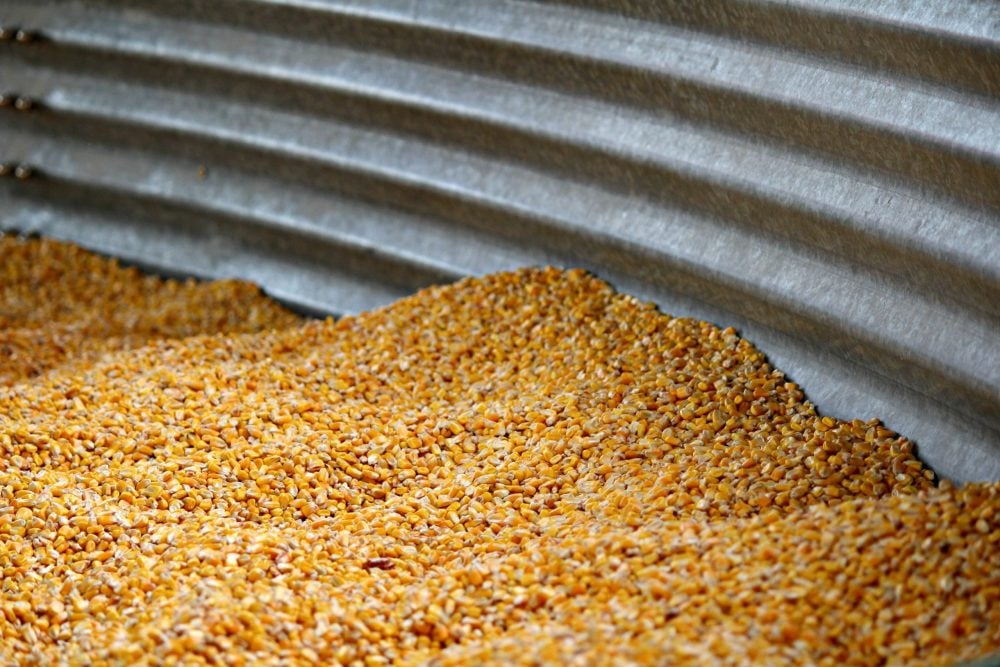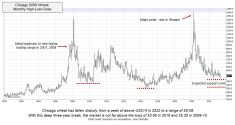Below average temperatures in early June delayed Ontario corn and soybean development. Precipitation levels were considered average. Warmer temperatures were needed to advance crop development and enhance yield potential.
The Ontario winter wheat crop is heading, and the onset of fusarium was a major risk. U.S. corn and soybean crops are developing under optimal conditions but dry weather forecasts for July and August are a concern. The U.S. winter wheat harvest is in the early stages and the wheat market will remain under pressure over the next few months.
Read Also

Cycle swings dictate farming profitability
It can be profitable to understand where the crop markets are positioned in the context of their big-picture cycles.
Soybeans
Ontario domestic soybean prices are relatively unchanged from last month. Ontario soybean stocks are expected to drop to historical low levels at the end of the 2024/25 crop year. The domestic market continues to ration demand away from export channels.
At the time of writing this article, Ontario crusher bids were averaging $14.13/bu. while just south of the border, bids were C$14.52. Earlier in spring, we were expecting Ontario to import about 250,000 tonnes during the summer months, but so far the market structure is not encouraging imports.
Domestic crushers take their downtime for upgrades and maintenance during July and August. Sometimes, the commercial trade occurs on large volumes at different prices to the local market. I know this as a merchant. If a company raises the prices by 30 cents/bu., they will buy limited volumes in the country.
However, providing a $5/tonne premium to a commercial trader they will sell you 50,000 tonnes. Keep this in mind. The import business may be completed and that’s why we are not seeing the strength in local old-crop bids.
During the last week of May, Brazilian soybeans were offered at US$415/tonne f.o.b. Paranagua, up US$7/tonne from two weeks earlier. U.S. soybeans were valued at US$417/tonne f.o.b. the Gulf, down US$3/tonne from our previous issue. Ontario soybeans were quoted at US$410/tonne f.o.b. the St. Lawrence, unchanged from late May.
At the time of writing this article, Chinese tariffs on U.S. soybeans totalled 34 per cent. We’re expecting China to step forward for Ontario soybeans in July and August. We continue to forecast an Ontario crop size of 3.9 million tonnes, down from the 2024 output of 4.3 million tonnes and down from the five-year average of 4.1 million tonnes.
The U.S. soybean crop is developing under favourable conditions. Traders feel comfortable with the USDA’s forecast of 118.2 million tonnes, down from last year’s figure of 118.8 million but up from the five-year average of 112.3 million.
The weather forecast for the western half of the Midwest calls for below normal precipitation and above normal temperatures for July and August. If this forecast materializes, we’re expecting the soybean market to rally $1-$1.50/bu.
What to do: We’ve advised farmers to be 90 per cent sold on their 2024 production and 10 per cent sold on their expected 2025 output.
Corn
A year-over-year increase in exports continues to support Ontario corn prices. Canadian corn exports for the week ending June 1 were 146,300 tonnes. Crop year-to-date exports were 2.5 million tonnes, up from one million tonnes last year. Commercial stocks are decreasing and the domestic basis is functioning to attract farmer selling.
Producers have been on the sidelines during the planting and spraying period. Elevator bids have become quite variable across Ontario because some companies are short on supplies. Most feedlots have their June and July requirements covered but the northern operations may need to increase bids if they’re short. Ethanol producers need coverage for August and September.
In mid-June, Brazilian corn was offered at US$205/tonne f.o.b. Paranagua, down US$10/tonne from 14 days earlier. U.S. corn was valued at US$203/tonne f.o.b. the Gulf, also down US$10/tonne from our previous issue. French corn was marked at US$216/tonne f.o.b. La Pallice, down US$4/tonne from our previous issue. Ontario corn was offered at US$220/tonne f.o.b. St. Lawrence port. The Ontario corn market is rationing demand by trading at a premium to world values.
The Argentine corn harvest was 41 per cent complete as of June 5. Crop estimates continue to hover around 50 million tonnes, down from last year’s crop of 51 million tonnes.
In Brazil, the first corn crop is estimated at 20 million tonnes and the harvest is 80 per cent complete. The second corn crop is estimated at 108 million tonnes and the harvest is in the early stages. The third crop is estimated at two million tonnes.
Total Brazilian output is estimated at 130 million tonnes. Brazil will dominate the export market as the second crop harvest progresses.
In the U.S, the crop was estimated at 401 million tonnes on the May WASDE Report. However the weather forecast for July and August suggests there could be significant yield drag in the states of North Dakota, Minnesota, Iowa and the non-irrigated regions of Nebraska. This could trim about 20 million tonnes of corn off the current crop forecast.
In France, the crop was planted into drier conditions and most of the country has experienced below normal precipitation during May.
Ongoing harvest progress in Brazil will weigh on the world market. The corn crops in the U.S. and France are expected to suffer yield drag. This will enhance U.S. and French export offers later in summer. European buyers are expected to step forward for Ontario corn in late July and early August.
What to do: We’ve advised farmers to be 80 per cent sold on their 2024 corn production. We are planning to make our final sales recommendation in late June or July during the main weather rally.
Wheat
The domestic and world wheat markets are digesting world crop conditions.
In Ontario, old crop stocks are extremely tight. At the same time, domestic millers need coverage for July. New crop supplies coming on stream in August. Fusarium will be a problem this year and actual milling volume will be lower than earlier anticipated.
We continue to forecast a crop size of 2.8 million tonnes, up from the 2024 output of 2.4 million tonnes and up from the five-year average of 2.6 million tonnes. We expect one million tonnes of Ontario wheat will trade into domestic feed channels from Aug. 1 through Dec. 31.
World wheat offers are relatively unchanged from 14 days earlier. As of June 9, Russian wheat offers for July loading were in the range of US$225-US$228/tonne f.o.b. Black Sea. U.S. hard red winter wheat was offered at US$240/tonne f.o.b. the Gulf while U.S. soft red winter was valued at US$226/tonne f.o.b.
French soft wheat was quoted at US$220/tonne f.o.b. Rouen. Australian standard white wheat was quoted at US$250/tonne f.o.b. Port Adelaide, South Australia.
In the U.S., a portion of the hard red winter and softer red winter have received above normal precipitation over the past 30 days. The harvest is in the early stages and we expect there will be quality issues.
U.S. farmers sell nearly 50 per cent of the winter wheat crop in the summer months. Cash prices for U.S. hard red and soft red winter wheat need to trade low enough to push a large volume into feed channels from June 1 through Sept. 30.
France and Germany continue to experience drier conditions. The main harvest occurs in July and farmers in Europe also sell a large volume at harvest due to limited on-farm storage. The crop will be higher quality and above normal protein.
Australian farmers are currently planting the crop and it’s rather dry across the country. Similar to Western Canada, Australia is prone to regular droughts and this is likely the year after a couple bumper harvests.
The Russian crop appears to be in good shape with the main harvest occurring in July and August. Ukraine has been on the drier side but it’s less of a market influence.
What to do: We’ve advised Ontario farmers to be 100 per cent sold on their 2024 milling and feed production. Farmers with feed quality wheat should sell about 30 per cent of the crop in the summer prior to the main corn harvest. Our first milling sale will occur in October. Be prepared to store your milling wheat because the world will be awash with supplies from July through September.















